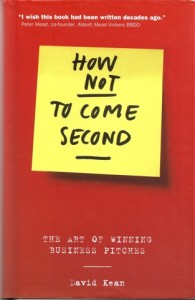The one-sentence summary
Present something ingenious, express it simply, stick to the point, and solve the problem.
- This book is sub-titled The Art of Winning Business Pitches
- The author used to work at Lowe, DDB, and Omnicom
- It constantly returns to the point that it is all about the winning. Far too many pitches fail because people don’t do the simple things and get distracted
- Elements of getting it wrong include: deluding yourself that you were a very close second; trying to over complicate things that are actually simple; and, people who are professionals most of the time acting like amateurs in the pitch process
WHAT’S GOOD ABOUT IT
- Although it’s all obvious stuff, clients want a good team, people who understand them and their business, some fun and stimulation, good value, and problem solving. There is many a pitch that does not deliver these
- The ingredients for successful pitching are:
1. Be organised
2. Know your audience (many agencies pitch blind)
3. Solve the problem
4. Price properly (note – not “cheaply”)
5. Practice (methodically, not at the last minute)
6. Great presentations
7. Unstoppable momentum
8. Feedback
- Other advice includes compiling the pitch bible, meeting everyday, brainstorming with the top talent, networking like crazy, and having a mole on the client side
- It identifies four types (expressives, amiables, drivers, analyticals) who may be present on your team and the client side. They require careful casting
- Pitch on a postcard is a good idea – if you can’t fit your argument on one, it’s not good enough
WHAT YOU HAVE TO WATCH
- The author is English but the book has been adapted for an American audience
- It briefly falls back on De Bono’s Six-Hat Thinking, which isn’t new

